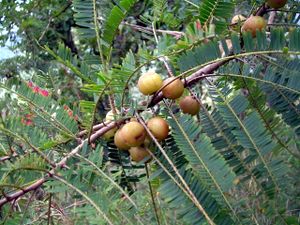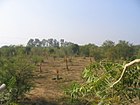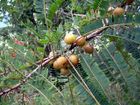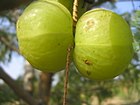Note: This is a project under development. The articles on this wiki are just being initiated and broadly incomplete. You can Help creating new pages.
Phyllanthus emblica - Triphala
Amalaki is an Ayurvedic herbal rasayana formula consisting of equal parts of three myrobalans taken without seed.
Contents
- 1 Uses
- 2 Parts Used
- 3 Chemical Composition
- 4 Common names
- 5 Properties
- 6 Habit
- 7 Identification
- 8 List of Ayurvedic medicine in which the herb is used
- 9 Where to get the saplings
- 10 Mode of Propagation
- 11 How to plant/cultivate
- 12 Commonly seen growing in areas
- 13 Photo Gallery
- 14 References
- 15 External Links
Uses
Diabetes, Jaundice, Stomachache, Gynaecological disorder, cough, mouth ulcer, heart problems, Diarrhea, asthma, cold
Parts Used
Chemical Composition
Triacontanol (1), Triacontanoic acid (2), β-Amyrin ke- tone (3), Betulonic acid (4), Daucosterol (5), Lupeol acetate (6), β-Amyrin-3-palmitate (7), Gallic acid (8), Betulinic acid (9), Ursolic acid (10), Oleanolic acid (11), Quercetin (12) and Rutin (13)[1]
Common names
| Language | Common name |
|---|---|
| Kannada | Betta Nelli |
| Hindi | Aonla, Amla |
| Malayalam | Nellikka, Amalakam |
| Tamil | Konkam |
| Telugu | Amalakamu |
| Marathi | NA |
| Gujarathi | NA |
| Punjabi | NA |
| Kashmiri | NA |
| Sanskrit | Amalakah |
| English | Indian Gooseberry |
Properties
Reference: Dravya - Substance, Rasa - Taste, Guna - Qualities, Veerya - Potency, Vipaka - Post-digesion effect, Karma - Pharmacological activity, Prabhava - Therepeutics.
Dravya
Rasa
Tikta (Bitter), Kashaya (Astringent)
Guna
Laghu (Light), Ruksha (Dry), Tikshna (Sharp)
Veerya
Ushna (Hot)
Vipaka
Katu (Pungent)
Karma
Kapha, Vata
Prabhava
Habit
Identification
Leaf
| Kind | Shape | Feature |
|---|---|---|
| Simple | Alternate | Bark light grey and exfoliating. Leaf feathery, smaller towareds the apex and the base, tip reddish |
Flower
| Type | Size | Color and composition | Stamen | More information |
|---|---|---|---|---|
| Unisexual | 2-4cm long | reddish | 5 | Flowering from March-April |
Fruit
| Type | Size | Mass | Appearance | Seeds | More information |
|---|---|---|---|---|---|
| 7–10 mm (0.28–0.4 in.) long pome | Fruiting May onwards | A depressed-globose drupe | many | {{{6}}} |
Other features
List of Ayurvedic medicine in which the herb is used
- Vishatinduka Taila as root juice extract
Where to get the saplings
Mode of Propagation
How to plant/cultivate
A plant mainly of the hot, tropical lowlands, succeeding in both humid and semi-arid areas[3]
Commonly seen growing in areas
Mixed forests, Drier forests, Dry open sparse forests or scrub.
Photo Gallery
References
External Links
- Ayurvedic Herbs known to be helpful to treat Diabetes
- Ayurvedic Herbs known to be helpful to treat Jaundice
- Ayurvedic Herbs known to be helpful to treat Stomachache
- Ayurvedic Herbs known to be helpful to treat Gynaecological disorder
- Ayurvedic Herbs known to be helpful to treat cough
- Ayurvedic Herbs known to be helpful to treat mouth ulcer
- Ayurvedic Herbs known to be helpful to treat heart problems
- Ayurvedic Herbs known to be helpful to treat Diarrhea
- Ayurvedic Herbs known to be helpful to treat asthma
- Ayurvedic Herbs known to be helpful to treat cold
- Herbs with Dried Folaige used in medicine
- Herbs with Whole herb used in medicine
- Herbs with common name in Kannada
- Herbs with common name in Hindi
- Herbs with common name in Malayalam
- Herbs with common name in Tamil
- Herbs with common name in Telugu
- Herbs with common name in Sanskrit
- Herbs with common name in English
- Habit - Herb
- Index of Plants which can be propagated by Seeds
- Index of Plants which can be propagated by Cuttings
- Herbs that are commonly seen in the region of Mixed forests
- Herbs that are commonly seen in the region of Drier forests
- Herbs that are commonly seen in the region of Dry open sparse forests or scrub
- Herbs







